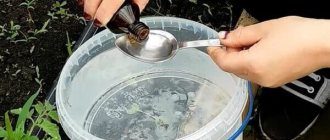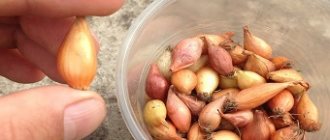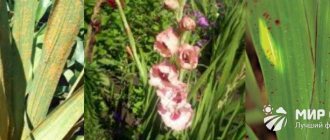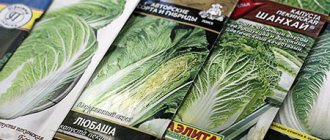The secrets of a good cabbage harvest lie in selecting a suitable variety, observing the timing of planting seedlings in prepared mail, careful planting in a suitable place and proper care. This is a cold-resistant and light-loving crop that grows in almost all regions of Russia.
Soil acidity in the range from 6.5 to 7.5 and a temperature range of 17-19°C are considered optimal for cabbage growth.
Care measures include abundant watering, thorough loosening, proper hilling, treatment against pests and diseases, and timely application of feeding compounds.
Requirements for light and heat
Cabbage is resistant to low temperatures. The thermal regime should be taken into account when growing seedlings. The optimal temperature for preparing seedlings is 15-20°C. Under such conditions, at least 90% of seed hatching and seedling formation occurs. Increasing the temperature to 25 ° C impairs germination. Therefore, it is more expedient to grow seedlings in a greenhouse or room. Do not cover the soil with seeds with film. This may cause overheating.
Favorable temperature conditions for seedling growth:
- cabbage varieties – 12-15°C;
- Chinese cabbage – 16-18 °C;
- cauliflower – 16-18 oC.
At night, it is necessary to maintain a temperature limit of at least 8-10 oC.
After transplanting cabbage seedlings of any type into open ground, the optimal temperature conditions for its growth and setting a head of cabbage are 18-22 ° C.
For planting cabbage, it is better to choose open, ventilated places. Cabbage is a light-loving crop, so it should not be planted near buildings or tall plants. The longer the daylight hours, the more intense the cabbage will grow.
Cleaning and storage
Cabbage can be harvested from the garden when the air temperature drops to -1 -2 °C at night. At lower temperatures, the heads of cabbage are likely to freeze, which cannot be allowed to happen - the level of keeping quality will decrease. Watering is stopped 2.5-3 weeks before the planned harvest. This is necessary so that starch accumulates in the heads, which contributes to a better storage process.
The forks are dug up with a shovel along with the roots and left for a day under a canopy. In the open air, the heads dry out or, as people say, become weathered. Next, they are sorted into healthy and defective. Cabbage touched by rot, pests, or spoiled during harvesting is set aside - it must be used first. The stalks are removed with a knife, leaving about 2 cm to the head, and the 3-5 outer covering leaves are left untouched. The preparatory work is done - the harvest can be stored in storage.
Related article:
How to Grow Super Large Heads of Cabbage
The ideal place to store cabbage, as well as other vegetables, is the cellar. The optimal temperature regime is +1… -1°С. Air humidity - 90-98%. As a rule, the temperature in cellars does not drop below zero and does not rise above 5-6 ° C, but, just in case, it doesn’t hurt to hang a thermometer there.
Good to know: Cabbage varieties that can be stored for a long time
To eliminate the possibility of mold, the walls in the room must first be whitewashed with lime. Remove trash and all unnecessary things. If there is no ventilation system, the cellar is ventilated periodically, about once every month and a half. Prepare racks that are installed horizontally in tiers. Alternatively, you can get by with wooden panels laid on the ground.
Forks are laid out on racks or suspended from the ceiling. To do this, the heads of cabbage are tied in pairs with a rope by the stalks and hung on special poles. This way they will be provided with uniform air access, plus it is convenient to examine them for damage. You can store cabbage in boxes stacked on shelves, or in buckets covered with sand.
Related article:
Broccoli - growing it right
Watering cabbage
Cabbage grows well with regular, abundant watering. White cabbage is moisture-loving. If you live in a region with an arid climate and infrequent rain, it is more advisable to give preference to kohlrabi and savoy cabbage. These species are not much inferior to white cabbage in terms of taste and benefits and have a buried root system, which provides the plant with moisture from the deep layers of the soil.
When to water cabbage
At the stage of planting seedlings, it is undesirable to overwater the soil in which the seeds are planted. The root system must independently develop deeper in order to subsequently feed the vegetable from the depths. As the seedlings grow, the volume of watering should be increased. Young cabbage requires watering in a volume of at least two liters per plant.
Important! At the stage of setting heads or forming a flower head, cabbage should be watered abundantly due to its high moisture requirement. The volume of water should be at least 3-4 liters.
Watering in small quantities is fraught with insufficient development of the root system and growth deficiency of cabbage. The optimal watering time is morning and evening. It's best to water your vegetables before the hot midday sun sets in to prevent moisture from quickly evaporating from the plants and soil. You should wait until it cools down in the evening. The volume of watering is reduced two weeks before harvesting. Otherwise, the heads of cabbage will crack.
How to water cabbage correctly
It is more advisable to water cabbage from the edge of the hole to prevent the soil from being washed away and the formation of holes. Do not use a high-pressure jet. It is better to use a sprinkler mounted on the spout of a watering can or hose. This will ensure complete watering and effective wetting of the soil.
What water is better to water cabbage
Cabbage is undemanding to water quality. To obtain heads of cabbage without endangering your health, it is recommended to use running, settled water. The culture tolerates cold water well. Water from nearby natural reservoirs should not be used for irrigation due to the content of silty particles that can get between the leaves and contribute to rotting.
Important!
To protect the heads of cabbage in hot weather, cover the cabbage with non-woven cloth. The material is not removed during watering, since the structure of the fabric does not prevent the penetration of water. The event not only effectively retains moisture and creates optimal conditions for growth, but also protects the plant from pests.
Loosening cabbage
Another measure aimed at obtaining a good harvest of cabbage in open ground is loosening. It is necessary to saturate the soil with oxygen and remove excess moisture from the soil. After watering, the soil becomes compacted and needs to be loosened and at the same time get rid of weeds. For these purposes, use a small garden tool with curved teeth.
The timing for loosening cabbage is as follows:
- the first loosening is 3-5 days after transplanting cabbage seedlings into open ground. The soil around the plant is loosened to a depth of no more than 5-6 cm;
- the second loosening - 10-12 days after the first. The soil is loosened to a depth of 10-12 cm;
- subsequent loosening is carried out together with hilling.
The depth and frequency of loosening should be adjusted depending on the condition and type of soil. It is recommended to loosen heavy clay soils more often.
How to properly grow cabbage seedlings
growing cabbage
Growing cabbage, or rather its seedlings, begins with the purchase of seeds. The manufacturer is important when choosing them. It would be more correct to choose already known and proven ones. Information about them is always on the packaging.
We can suggest you pay attention to such as “Gavrish”, “Aelita”, “Plasma”. Don't forget to also check the production date. Seeds older than 5 years should not be used, as their germination rate is very low.
If you decide to purchase seeds that have a bright shell, you can immediately sow them in the garden, since they have already been prepared by the manufacturer.
Hilling cabbage
Hilling is the procedure of lifting and loosening the soil around a plant to form a hillock. The event promotes:
- development of adventitious roots;
- weed control;
- saturation of the soil with oxygen.
Hilling should be done when the soil is moist. The procedure begins with the appearance of new cabbage leaves after transplanting the seedlings into open ground. The second hilling is carried out 10-12 days after the first hilling. The next hilling must be carried out during the formation of a head of cabbage or the formation of a colored head.
On a note!
Cabbage with a short stalk does not need frequent hilling. One procedure after planting seedlings at the stage of formation of new leaves is enough.
During the hilling procedure, Brussels sprouts are strengthened by tying the plant to a peg.
Growing cabbage from seeds
How to sow seeds
The quality of cabbage primarily depends on the seed, so be responsible when purchasing seeds and before growing cabbage seedlings, think about why and when you want to get it - do you need an early vegetable with delicate leaves for salads or strong, dense heads of cabbage? for winter storage and salting. The choice of variety and sowing time will depend on the intended purpose of the cabbage you grow.
- Description of black tomato varieties
Widely cultivated by amateur gardeners, white cabbage, without which no borscht is complete, comes in early varieties that are suitable only for eating in the summer, mid-season varieties that can be eaten fresh in the summer or can be salted for the winter, and late varieties that More than any other, they are suitable for long-term storage.
Sowing of early varieties of cabbage for seedlings is carried out from the first days of March to the twentieth of the month, seeds of mid-season varieties are sown from March 25 to April 25, and late cabbage is sown from the beginning of April to the third decade of the month. From the moment of sowing until the seedlings are planted in open ground, it usually takes 45-50 days.
If you have decided on your desires and purchased the seeds of the desired varieties, it’s time to think about making soil for seedlings. Professionals recommend preparing the soil mixture in the fall so that you don’t have to extract the ingredients from under the snow in winter. Mix one part each of humus and turf soil, add ash at the rate of 1 tablespoon per kilogram of soil and mix the composition well. The ash will act as an antiseptic and a source of macro- and microelements, preventing the appearance of black leg on cabbage seedlings.
You can prepare a mixture of a different composition, based on peat, for example - the main thing is that it is fertile and breathable. Never use garden soil from a plot where cruciferous crops were grown to grow seedlings, as it is likely that it contains pathogens that can affect the seedlings.
Growing cabbage begins with heating the seeds for 20 minutes in water at a temperature of about 50 ºC, after which they are immersed in cold water for 5 minutes to increase the immunity of the seed to fungal diseases. Then the seeds are immersed for several hours in a solution of a growth stimulant - Humate, Epin, Silk, etc. However, there are varieties whose seeds cannot be wetted - carefully read the instructions attached to the bag of seeds.
Water the soil generously before sowing and do not moisten it further until germination. The seeds are sown to a depth of 1 cm, then the container is covered with film or paper on top so that moisture from the top layer of soil does not evaporate, and the crops are kept at a temperature of 20 ºC.
Growing seedlings
Shoots appear already on the 4-5th day, after which the film or paper is removed, the temperature is lowered to 6-10 ºC and the seedlings are kept in these conditions until their first true leaf appears. To do this, it is best to place the container with seedlings on a glassed-in loggia, and usually a week is enough to achieve the expected result. After the leaf appears, the temperature on sunny days is increased to 14-18 ºC, on cloudy days it should be within 14-16 ºC, and at night – 6-10 ºC.
Caring for cabbage seedlings at this stage provides the plants with access to fresh air, but the seedlings must be protected from drafts. In addition, seedlings need additional illumination with a fluorescent or phytolamp: their daylight hours should be at least 12-15 hours a day.
Do not allow the soil to dry out or become waterlogged - this can be avoided by regularly loosening the soil after watering. A week after the emergence of seedlings, the soil is watered with a weak solution of potassium permanganate at the rate of 3 g of potassium permanganate per 10 liters of water, or a weak solution of copper sulfate.
Cabbage pick
One and a half to two weeks after the emergence of seedlings and the formation of the first true leaf, the plants dive, providing the seedlings with a large feeding area. An hour before planting the cabbage, the soil with the seedlings is watered abundantly, then each seedling is removed along with a lump of earth and, having shortened its root by a third of its length, it is planted in an individual cup (preferably peat-humus), buried down to the cotyledon leaves.
Picking can be avoided if the initial sowing of cabbage seeds is carried out in individual containers - when transplanting seedlings into open ground from personal pots, the root system of the seedlings is not so damaged, and by the time the seedlings are planted in the garden bed, it will have already developed to a decent size. If you grow seedlings in peat-humus pots, then you can plant the seedlings in the ground directly in them.
Planting cabbage in the ground is preceded by two weeks of hardening, the purpose of which is to prepare the seedlings for development in new conditions. The first two days in a room with seedlings, open the window for 3-4 hours, providing protection for the seedlings from drafts. Then, over the course of several days, the seedlings are taken out for an hour or two on a balcony or loggia under the sun’s rays, from direct exposure of which the seedlings must first be covered with gauze.
After a week, reduce watering, take the seedlings to the balcony and keep them there until planting in the ground.
- Marking F1 on a package of seeds - what does it mean?
Feeding cabbage
To ensure a rich harvest of cabbage, it must be fed regularly. The time and composition of fertilizing depends on the type of crop, the type of soil for seedlings and the condition of the soil where the cabbage will be planted.
Particular attention should be paid to the period of intensive leaf growth and the phase of formation of a head of cabbage or a colored head. At this time, fertilizing with potassium is necessary for any variety.
Low temperatures weaken the soil and slow down all biological processes. Therefore, care should be taken to apply nitrogen fertilizers in the spring before the onset of stable heat.
Cabbage
Early varieties of cabbage need to be fed at least 2-3 times. Mid- and late-ripening cabbage varieties are fertilized 3-4 times per season. Top dressing should combine organic and mineral fertilizers.
Important!
When applying fertilizer in the form of dry mineral fertilizers, you should prevent them from getting on the leaves.
First feeding of cabbage
The first feeding is carried out 10-15 days after planting the seedlings. You must enter:
- the mineral composition for feeding cabbage should be at least 50-100 g per 10 sq.m. ammonium nitrate or a mixture of 100-150 g of urea, 70-100 g of superphosphate and 50-80 g of potassium salt.
- Organic fertilizing can be done from an infusion of weeds. To do this, you need to pour 5 parts of weeds with 1 part of water. You can add cow manure and bird droppings to the infusion at the rate of 1:10 and 1:20, respectively. Each plant must have at least 0.5 liters of fertilizer.
If the soil is sufficiently fertilized, then only nitrogen fertilizers are applied. To do this, you can only use ammonium nitrate or urea at the rate of 100-150 g per 10 square meters. m.
Might be interesting Growing carrots: planting and care Make your work easier - plant potatoes under straw Spring pear care is the basis of the harvest
Second feeding of cabbage
The second feeding is applied in the form of nitrogen fertilizer 10-15 days after the first feeding. The composition used is the same as in the first feeding. At least 1 liter must be used per plant.
Third feeding of cabbage
Feeding is carried out 15 days after the second application of fertilizing. It is necessary to water the plants with the following infusion - add an infusion of cow manure (in a ratio of 1:5) and 30 g of superphosphate to 10 liters of water. The solution is thoroughly mixed and poured onto plants at a rate of at least 1.5 liters per plant.
Fourth feeding of cabbage
The last fourth feeding is carried out 3-4 weeks before the expected harvest. The event is aimed at long-term preservation of heads of cabbage after harvesting. The fourth feeding is the application of a solution of 10 liters and 40 g of potassium sulfate. At least 2 liters should be poured under each bush.
Additional spraying
Spraying cabbage with a solution of microelements helps to obtain a rich harvest of heads of cabbage. To do this, prepare a solution from:
- 10 liters of water;
- 10 g manganese sulfate;
- 0.1 potassium iodide;
- 5 g boronodalite fertilizer;
- 2 g molybdenum ammonium;
- 3 g copper sulfate.
The solution is thoroughly mixed and the plants are sprayed with a sprayer.
Cauliflower
Cauliflower should be fed with a composition containing a predominance of potassium fertilizers. Organic fertilizer consists of 10 liters of water, cow manure infusion (1:5) and 40 g of superphosphate. The mineral composition is 100-150 g of ammonium nitrate per 10 sq.m. Fertilizers are applied every 15 days, alternating organic and mineral compositions.
During the period of setting a head of cabbage, it is necessary to fertilize the cabbage with boron and molybdenum.
Important!
Cauliflower grows well in alkaline soils. Therefore, it is advisable to apply at least 0.5 liters of a solution of 10 liters of water and 3 tbsp every 3 weeks under each bush. spoons of calcium nitrate. The composition can be replaced with a solution of lime or dolomite in a ratio of 10 liters of water to 200 ml of substance.
Broccoli
Broccoli is a capricious crop and is demanding on soil fertility. To get a good broccoli harvest, you need to apply nitrogen fertilizers in doses so as not to cause intensive leaf growth.
Brussels sprouts
Brussels sprouts should be fed weekly. For fertilizer, organic fertilizers are used in the form of a solution of cow manure in a ratio of 1:5 and a mineral composition of 10 liters of water and 3 tbsp. spoons of azofoska.
Leaf scraps
Tearing off the lower leaves of cabbage is not necessary due to the fact that they accumulate a supply of useful microelements and substances. Once the leaves are torn off, the plant will direct its growth to regrow them.
Another function of the lower leaves is to protect the head of cabbage from pests and a number of diseases. A waxy coating and a dense leaf protect the head of cabbage from drying out and evaporation of moisture from the soil. It is advisable to tear off the lower leaves only before harvesting the heads of cabbage. The torn leaves can be used to feed animals. They contain a lot of vitamin C. If you tear off the lower leaves while the head is setting, the head itself will contain less ascorbic acid.
Only yellow or rotten leaves should be torn off. You need to remove the cabbage leaf carefully, slightly retreating from the trunk and stalk. Cabbage juice may attract some pests. To prevent aphid invasion, dill, celery, calendula or marigolds are planted between the rows. Scented plants repel pests.
Protection from diseases
Cabbage is susceptible to a number of diseases during its growth process. Some of the most common are:
Blackleg
The disease affects the root collar in the form of a black or brown coating. As a result, the root becomes thinner and rots. The disease is favored by acidic and waterlogged soils. As a means of control, moderate watering and application of a solution of 1 liter of water and 0.5 manganese potassium to the seedlings are used;
Mucous bacteriosis
A disease that affects the plant during the head setting period. It manifests itself as yellowing of the leaves, the appearance of mucus on them, and the appearance of an unpleasant putrid odor from the crop. The cause of the disease is putrefactive bacteria carried by flies. Pollination with wood ash and watering with a solution of manganese sulfate also effectively helps in the fight against mucous bacteriosis;
Downy mildew
It is a fungal infection of leaves. Most often parasitizes seedlings. It has a grayish color. The disease is provoked by cold water and humid air. To prevent the appearance of powdery mildew, soak the seeds in hot water (50°C) before sowing, followed by immersion in cold water for 2 minutes. The fight against powdery mildew on adult plants is spraying with a solution of 10 liters of water and 40 g of colloidal sulfur. You can also use the finished substance "Energen". They treat the crop at the rate of 3 caps per 10 liters of water;
Kila
The disease manifests itself in the form of root growths of various sizes. The plant receives a sufficient amount of useful and nutrients through the root system. The cause of the disease is a fungus in the soil. A measure to combat clubroot is regular liming of acidic soils and an annual change of the place where cabbage is planted. It is also possible to treat the soil with copper sulfate and specially prepare the soil for seedlings;
White and gray rot
Diseases are typical for already cut heads of cabbage. To prevent the crop from rotting, it is necessary to warm the seeds in hot water before planting the seedlings. Dusting growing heads of cabbage with chalk also contributes to high-quality storage of the crop.
It is necessary to regularly inspect the plants in order to take timely measures to combat the disease.
Cabbage pest control
All gardeners who put their heart and effort into sowing, planting and caring for vegetables must be prepared to protect their wards from diseases and pests. The sad fact is that there are many dangers awaiting your delicious vegetables. It’s good to get to know the aggressor in advance in order to prepare to protect plants properly and on time. Nobody wants to use chemicals again in their garden. We invite you to learn about simple organic methods for protecting cabbage.
Cabbage fly (Delia radicum) - a favorite place for laying eggs is loose soil - females lay eggs on the root collar of cabbage, and then the larvae feed on the underground parts of the cabbage. Plants whose roots were attacked by cabbage fly larvae quickly died. To protect the cabbage, we must close off access to the soil around its roots:
- When you plant cabbage seedlings in open ground, we always firmly compact the soil around the root collar with our hands.
- When sowing cabbage seedlings, we place mats made of cardboard or old carpet at the base of the root collar. You can also use an old CD for this purpose.
- We place a fine white micro-mesh on the cabbage itself, which will not allow pests to enter from the air.
- Between the beds we plant plants such as lettuce, dill or calendula to deceive the cabbage fly.
Birds will peck at the tender, juicy leaves of your cabbage seedlings. And thus, she can completely die. To protect cabbage from birds, we must make it difficult to access the plants:
- For example, using any scarecrow, we attach a plastic tape to the stick, which produces rustling sounds at the slightest wind;
- You can use the same micro mesh or any other network;
- To confuse birds in the aisles, we plant lettuce, dill or marigolds.
The cabbage butterfly (Pieris brassicae) is a famous white butterfly whose caterpillars especially like to feed on cabbage. Females of the first generation lay eggs mainly on wild crops, but in July-August the next generation of butterflies prefers cabbage. Let's try to prevent butterflies from laying eggs on plants, and when caterpillars appear, let's remove them regularly:
- Use micro mesh in the beds;
- Use bioprotection in the form of bacteria Bacillus thuringiensis;
- We plant lettuce, dill or calendula between the rows to confuse the butterflies.
- Nasturtiums are a favorite food of cabbage caterpillars, so by planting them close to the cabbage we can lure the caterpillars out of the cabbage beds.
Leaf beetles (Chrysomelidae) - appear in the garden on dry and hot days and leave characteristic small holes on the leaves. To scare them away we can:
- Always keep the soil moist;
- Use micro mesh;
- Plant lettuce, dill or marigold between rows to weaken fleas.
- Plant radishes in the corners of a cabbage bed to "pull" fleas out of it - we will still only be eating its root, and the radish leaves can be sacrificed for the benefit of the cabbage;
- Strongly aromatic herbs such as thyme or mint can mask the smell of cabbage and deceive fleas;
Cabbage aphids (Brevicoryne brassicae) arrive in cabbage beds in early June and quickly take over the leaves of the plants they destroy. Here is a proposal for ecological control of cabbage aphids:
- Due to the fact that pests overwinter in the egg stage on the remains of plants left in the garden, always try to remove and destroy any remains of collected plants;
- In the fight against cabbage aphids, the biological weapon is the larvae of the seven-colored ladybug. To lure these beneficial insects into the garden, we plant among the rows of cabbage, umbrella plants, for example, dill, coriander, fennel, cumin.
- There are many recipes for fighting aphids using folk remedies. The cheapest and most effective remedy is vinegar. Spray the cabbage with a solution of 200 g of vinegar per bucket of water plus 40 g of soap, making sure to treat the lower part of the leaf.
Unfortunately, folk remedies do not always give 100% results in pest control, so prevention is a very important point: complete cleaning of the garden from plant debris in the fall, spring digging and systematic weeding.
Pest protection
Cabbage planted in open ground is susceptible to attacks by various insect pests. The most common are:
Cabbage whites
A butterfly with white wings and a black pattern on them lays eggs on the outside of cabbage leaves. The hatched caterpillars feed on the plant. The fight against whiteweed consists of spraying with a solution of 10 liters of water, 1 tbsp. l liquid soap and 2 cups wood ash;
Cabbage fly
The insect lays eggs next to the stem or on the stem itself. The hatched larvae infect the root system and eat the leaves. Protection against the pest is spraying with a strained solution of 10 liters of water, 100 g of tobacco dust and 1 teaspoon of ground black pepper. After the procedure and every 3 days, loosen the soil to a depth of at least 3 cm. An effective measure against flies is also the ready-made product “Iskra-M”. The solution is sprayed on the plants in accordance with the instructions;
Slugs and snails
They damage the leaves and root system of cabbage. The fight against them consists of sprinkling the soil with a mixture of 0.5 liters of wood ash, 1 tbsp. spoons of ground black pepper, 1 tbsp. spoons of salt, 1 tbsp. spoons of mustard powder. After applying the mixture to the ground, loosen the soil to a depth of 5 cm;
Cabbage scoop
A butterfly with gray wings that is active at night. The insect lays eggs on cabbage leaves. After hatching, the larvae grow into caterpillars that feed on cabbage. As a control measure, water with a solution of 10 liters of water, 1 tbsp. spoons of soap in liquid form, 2 tbsp. spoons of salt, 2 tbsp. spoons of mustard or mustard powder.
Important!
The ready-made product “Iskra-M” is effective against butterflies. Select a solution for caterpillars and spray with a solution of 5 liters of water and 5 ml of product. The solution consumption must be at least 1 liter per 10 square meters. m.
Aphid
Pests in the form of small insects that inhabit the outer side of cabbage leaves and feed on the sap of the plant. Spraying with a solution of 10 liters of water, 2 cups of wood ash and 1 tbsp is effective against aphids. spoons of liquid soap. The ready-made drug “Fufanon” is also effective against insects, which is diluted in 10 liters of water and 10 ml of the product, and the crop is sprayed in the afternoon. 10 liters of solution should be enough for 100 square meters. m.
Cabbage is a healthy and low maintenance crop. Regular watering and pest control will ensure a rich harvest in the fall. If you use all the recommendations for growing cabbage, then it will not be difficult for you to collect strong, juicy heads of cabbage in late September - early October.
Preparing the beds
Cabbage prefers to grow on fertile loamy soils with low acidity, enriched with humus. Also, the soil must have good moisture-holding abilities. The site for planting is usually prepared in the fall. After harvesting the previous crops, the soil is carefully dug up to the depth of a spade bayonet. The surface is not deliberately leveled with a rake, since the more unevenness there is, the better the soil will be saturated with moisture during the winter. In the spring, the so-called “moisture sealing” is carried out - the bed is dug up again, freed from weeds and leveled to a smooth surface.
Related article:
How to grow cauliflower without seedlings
Fertilizers can be applied in several ways:
- In the fall, before digging, the ground is treated with lime, dolomite flour or fluff at the rate of 400 g/m2. In the spring, compost or humus (1 bucket/m2), as well as superphosphate or nitrophoska (2 tbsp/m2) are added according to the same principle.
- In the spring, before digging, add compost or humus (1-2 buckets/m2), potassium sulfate (1 tbsp/m2), superphosphate (2 tbsp/m2).
- When planting, fertilizer is poured directly into the hole for greater efficiency of use. One serving contains: humus (0.5 kg), wood ash (2 tbsp), nitrophoska (1 tsp). In the hole, everything is mixed together with the soil, and seedlings are planted on the prepared cushion.
Tips for summer residents: Growing Brussels sprouts











